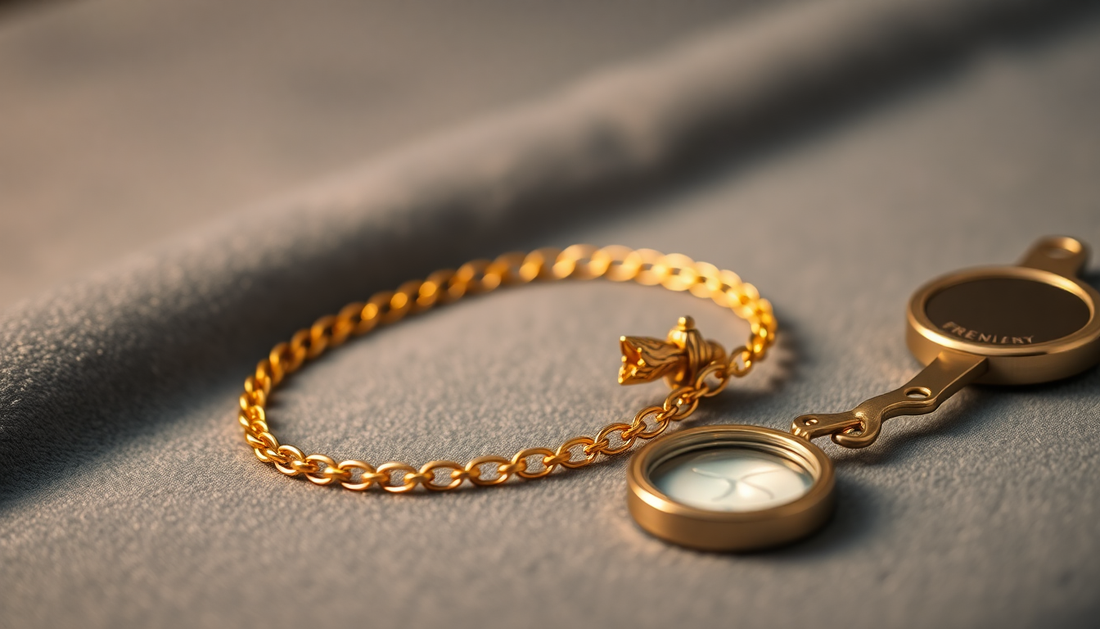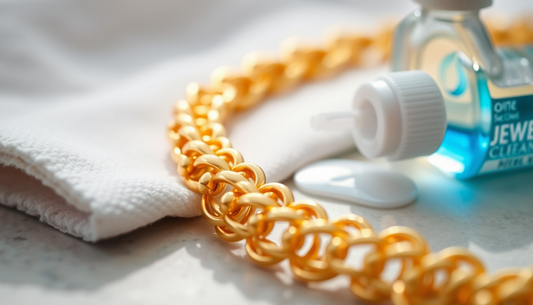
How to identify an authentic gold bracelet
Share
Introduction
In the world of jewelry, authenticity is key. When it comes to gold bracelets, being able to distinguish between the genuine and the fake is crucial. Whether you're looking for a piece for yourself or as a gift, it's important to know how to identify an authentic gold bracelet. In this blog, we'll explore the key methods and features that will help you ensure you're purchasing a quality piece of jewelry.
The importance of identifying authentic gold
Gold is a precious material that has been prized for centuries for its beauty, durability, and value. However, the proliferation of imitations and counterfeits on the market has made it increasingly difficult to distinguish between the genuine and the fake. Purchasing an authentic gold bracelet not only ensures that you are getting a quality product, but it also protects your investment.

A brief history of gold bracelets
Gold bracelets have a long and fascinating history. From ancient Egypt to the present day, these jewels have been used as symbols of status, wealth and power. Over the centuries, craftsmen have perfected the manufacturing techniques, giving rise to a wide variety of styles and designs.
Characteristics of gold
In order to identify an authentic gold bracelet, it is important to understand the physical properties of gold. This metal is characterized by its bright yellow color, high density, and resistance to corrosion. In addition, gold is classified into different carats, which indicate the purity of the metal.
Physical properties of gold: Gold is a soft and malleable metal, with a density of approximately 19.3 g/cm³. This makes it an ideal material for jewelry making, as it can be easily shaped and worked. In addition, gold is an excellent electrical and thermal conductor, making it even more valuable in various applications.
Different Karats of Gold: Gold is graded in different karats, which indicate the purity of the metal. Pure gold, which is 24 karats, is too soft to be used in jewelry without being easily damaged. Therefore, it is often mixed with other metals, such as silver or copper, to increase its hardness and strength. The most common karats in jewelry are 18k (75% pure gold) and 14k (58.3% pure gold).
Methods to identify a gold bracelet
There are several methods you can use to determine if a bracelet is real gold. From visual inspection to more advanced testing, each of these methods will help you make an informed decision.
Visual Inspection: One of the easiest ways to identify a gold bracelet is through visual inspection. Look closely at the piece, paying attention to its color, shine, and finish. Real gold has a bright, uniform yellow hue, with no spots or discolorations.
Magnet Test: Another simple test is the magnet test. Hold a magnet close to the bracelet and see if the bracelet is attracted to the magnetic field. Gold, being a non-magnetic metal, will not be attracted to the magnet. If the bracelet is attracted, it is probably not real gold.
Density Test: The density of gold can also be used as an indicator of authenticity. You can perform a density test by immersing the bracelet in water and measuring the volume of water displaced. You can then calculate the density of the piece and compare it to the density of pure gold, which is approximately 19.3 g/cm³.
Acid Test: A more advanced test is the acid test. This involves applying a drop of nitric acid or hydrochloric acid to the surface of the bracelet. If the piece is made of genuine gold, the acid will not produce any reaction. If, on the other hand, the bracelet is made of a base metal, the acid will react and leave a stain.
Using an Electronic Gold Tester: For a more accurate assessment, you can use an electronic gold tester. These devices measure the electrical conductivity of the piece and compare it to reference values for pure gold. This will allow you to accurately determine the karatage of the bracelet.
Marks and stamps on gold bracelets
In addition to physical evidence, marks and stamps present on the bracelet can also provide valuable information about its authenticity.
What Karat Stamps Mean Karat stamps, such as "18k" or "14k," indicate the percentage of pure gold present in the piece. These stamps are usually engraved or stamped in a visible location on the bracelet.
How to Interpret Manufacturers' Marks Many jewelry manufacturers also include their own brands or logos on gold bracelets. These marks can help identify the origin and quality of the piece.
Care and maintenance of gold bracelets
Once you have identified an authentic gold bracelet, it is important to know how to care for it and keep it in good condition.
Proper Cleaning To clean your bracelet, use a soft cloth and a jewelry cleaner specifically designed for gold. Avoid using abrasive products or harsh chemicals, as they may damage the finish of the piece.
Proper Storage When not wearing your bracelet, store it in a case or cloth bag to protect it from scratches and bumps. Avoid exposing it to moisture, heat or direct sunlight, as these factors may affect its appearance.

Buying authentic gold bracelets
When purchasing a gold bracelet , it is important to know where and how to buy to ensure you get an authentic piece.
Where to Buy Authentic Gold Bracelets The best options for buying authentic gold bracelets are from reputable jewelry stores, specialty stores, or trusted sellers. Avoid shopping at informal markets or through unverified channels, as there is a higher risk of acquiring imitations.
What to Look for When Buying a Gold Bracelet When shopping for a gold bracelet, pay attention to karatage stamps, manufacturer marks, and the quality of the finish. Ask for a certificate of authenticity and make sure the piece comes with appropriate warranties.
Common myths and misconceptions about gold bracelets
Over the years, a number of myths and popular beliefs have been generated about gold bracelets. It is important to be aware of these to avoid falling into common mistakes.
Debunking popular beliefs Some common myths include that gold can be identified by its weight, that fake gold is always cheaper, or that white gold is not authentic. It is important not to be guided by these preconceptions and to rely on the most reliable identification methods.
Common mistakes when identifying gold Another common mistake is confusing gold with other metals of similar color, such as brass or copper. It is also important to note that gold can have different shades, depending on the metals with which it has been alloyed.
Summary of identification methods
- Visual Inspection: Observe the color, shine and finish of the bracelet.
- Magnet Test: Bring a magnet close to the bracelet and check if it is attracted.
- Density Test: Measure the volume of water displaced and calculate the density.
- Acid test: Apply a drop of acid and observe for reaction.
- Using an electronic gold tester: Measure the electrical conductivity of the piece.
The importance of authenticity in jewelry
Purchasing an authentic gold bracelet not only guarantees the quality of the piece, but also protects your investment. By correctly identifying gold, you ensure that you are getting a piece of jewelry that will maintain its value over time and that you can enjoy with the peace of mind of knowing that it is genuine.



